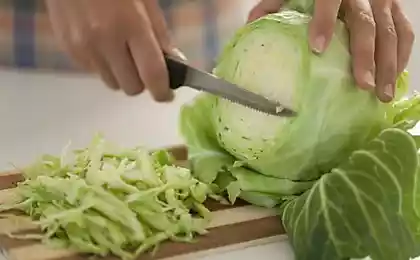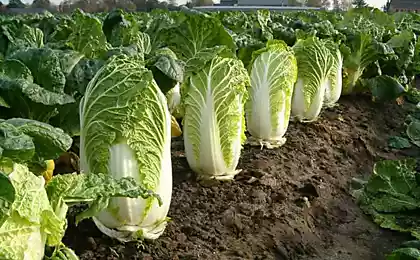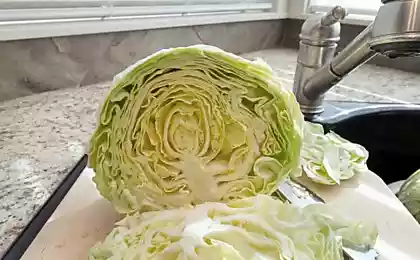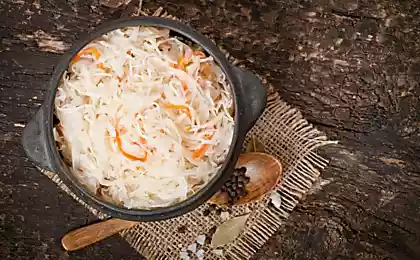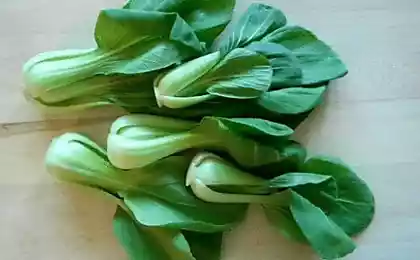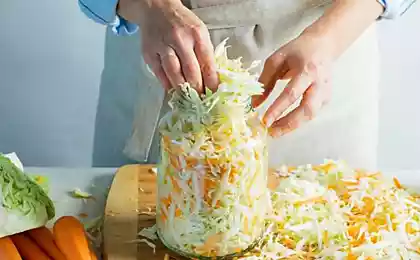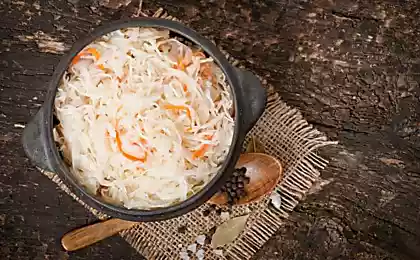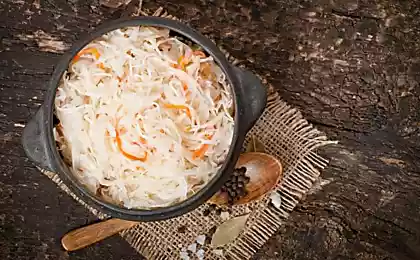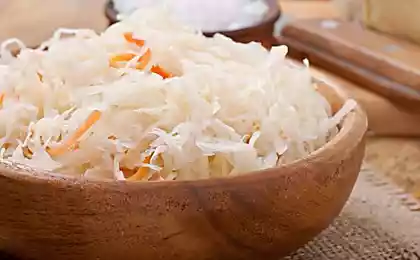696
How to grow ornamental cabbage
Want to find the original and undemanding ornament for the garden can please the eye even in late autumn? Then hurry up to get acquainted with ornamental cabbage and you'll likely want to grow her own lush outlet.
What is ornamental Kale?
Essentially decorative cauliflower – this is the collective name of several varieties of cabbage leaf. It is a biennial plant that in the first year of vegetation, it develops a leaf rosette, and in the second year, flowering and fruiting. For decorating the area used the plants the first year.
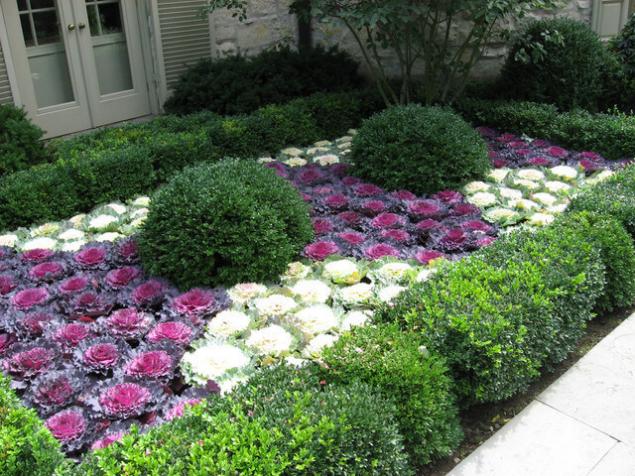
Depending on variety flower cabbage decorative tall able to achieve from 20 to 130 cm and in diameter up to 1 m. Special decorative effect different leaves which may have a different shape and color of leaves. Sheet size different serogroup varies from 20 to 60 cm in length and from 10 to 30 cm in width. Ornamental Kale perennial surprising variety of forms sheet plate, which can be ovate and obovate, elliptical, and truncated ellipticheskoi. The edges of the leaf are serrated and silnoroslye. Surprising and painting the socket in which white, pink, purple, cream blend with light green or bluish-green.
Almost all varieties of ornamental cabbage light-requiring, but can grow in partial shade, however, full sun cabbage get larger, and the coloration is brighter.
How to grow ornamental cabbage:
soil preparation
Farming of cabbage decorative is virtually indistinguishable from the technology of cultivation of familiar cabbage. Planning to grow this plant, it should be remembered that it is better grown on loamy and sandy soils. For a good harvest and achieve the highest ornamental plants land for its growing better prepare since autumn. In particular, at this time, it is recommended to make fertilizer. 1 m. make the compost (3-4 kg), ammonium sulfate (20 g), potassium chloride (15 g), superphosphate (42 g). All fertilizers carefully buried in the soil. If the level of acidity of the soil is increased, then reduce it by using lime.
In the spring before planting ornamental cabbage in the soil at the site loosened and re-aligned. Choosing land for cultivation, it should be remembered that cabbage grows well in the places where she grew tomatoes, potatoes, onions, legumes, cucumbers and root vegetables.
Planting ornamental cabbage
It should be noted that the decorative cabbage, planting and care which, incidentally, is not distinguished by special difficulties, traditionally grown from seed in seedling method. The seedlings are sown in containers or greenhouses or in open ground.
1. Planting ornamental cabbage in the pot.
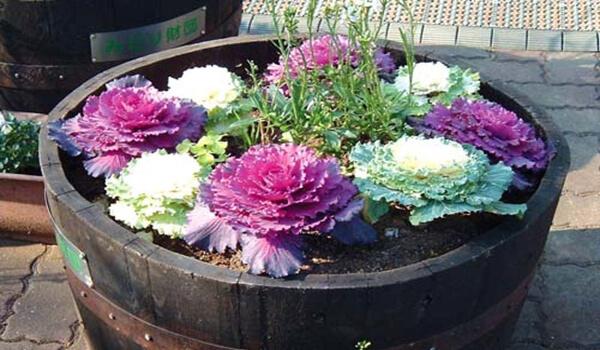
Growing ornamental cabbage from seed starts in late March and early April, when in small pots with a diameter of about 3-4 cm were sown at 2 seeds and buried them in the soil to a depth of about 1 cm Before sowing, the soil should be treated with a fungicide in order to avoid destruction of young plants of "blackleg".
If you keep sowings at a temperature of 18-20 degrees, then after about 2-5 days to sprout the first shoots. Care of such seedlings is simple. As soon as friendly growth, the seedlings are transferred to a cooler room. Care of seedlings, ornamental cabbage is simple. Periodically moderately watered young plants. With the emergence of the second true leaf and approximately 14 days before planting in open ground the seedlings are fed, using, for example, Kemira Wagon or NPK per 1 m sq of 1 tablespoon of fertilizer.
At the end of April – early may, pre-hardened seedlings are planted in open ground. By that time each plant should be 4 or 5 leaves. By the way, to plant ornamental cabbage once a permanent place is optional. Since the peak of its decoration is in the fall, its a long time you can grow in the garden, and by the autumn to replant in the garden.
2. Planting ornamental cabbage in the greenhouse.
For planting seedlings in the greenhouse, as, indeed, and containers, prepare the soil mixture consisting of sand, peat and garden soil at the rate of 2:1:2. It is important that the prepared layer of soil reached about 10-15 cm Before seeding, the soil is treated with a solution of potassium permanganate or fungicide for disinfection and prevention of fungal diseases of seedlings.
Seeds spread on 2 pieces in small dimples with a depth of about 1 cm and cover them with earth. To speed up germination, crops covered with foil. At this stage, the temperature in the greenhouse should be approximately 20 degrees. With the emergence the temperature was lowered to 12 degrees. Seedlings provide moderate watering and periodically loosen the soil. Planted in open ground the young shoots of the ornamental cabbage you can already with the advent of the second sheet.
3. Planting ornamental cabbage in the open ground.
As practice shows, the ornamental cabbage, planting and care which is originally carried out in open ground, is more hardened and resistant to negative environmental effects. To sow ornamental cabbage in the open ground starting from the beginning of April (if allowed by weather and climatic conditions of the region), providing crops for the first time a film cover.
Seeds are sown in loose soil, according to scheme 5 by 5 cm, closing up to a depth of 1.5 cm When sprouts appear, the crops thinned out, leaving stronger plants. In the future, as necessary, watered the seedlings, remove the weeds and loosen the soil.For permanent seedlings are transplanted 30-45 days, positioning plants according to the scheme 70 by 70 cm.
Further, to obtain large lace rosette decorative cabbage, you need to provide her timely care.
How to grow ornamental cabbage: particular care
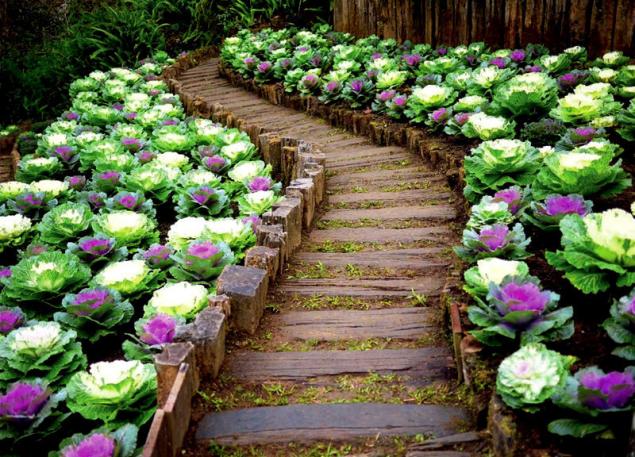
This unusual decorative cabbage, growing and care which at times surprises with its simplicity, as well as other garden inhabitants, requires some attention.
The basic techniques of caring for ornamental cabbage are periodic loosening of soil with simultaneous destruction of weeds and regular abundant watering, the frequency of which is determined based on the characteristics of the soil and weather conditions. When growing ornamental cabbage in containers with a volume of 10-15 l watering is carried out every three days, but in the heat and every day. This kind of cabbage, the growth is quite powerful and surround the outlet, because the plant must periodically hill, in order to stimulate the appearance of additional roots and increase its stability.
Moreover, because of its simplicity ornamental cabbage is easy to transplant from place to place. During the season plant with a clod of earth can be transplanted 2-3 times. To quickly get accustomed on a new place, cabbage is recommended to feed a 1.5% solution of fertilizer, for example, "Kemira-Suite."
If before planting the soil was properly charged, then additional feeding throughout the season, she did not need. But if in advance to prepare the ground failed, then feed the ornamental cabbage can be in the soil. 10-14 days after transplanting to a permanent place of plants fertilized with urea or a solution of mullein, which is diluted at the rate of 1 liter cans 1 bucket of water. This fertilizer will promote more active growth of the leaves. The next stage of feeding is carried out 14 days after the first. This time, apply complex fertilizers with the same dosage that is used during landing.
Diseases and pests of ornamental cabbage
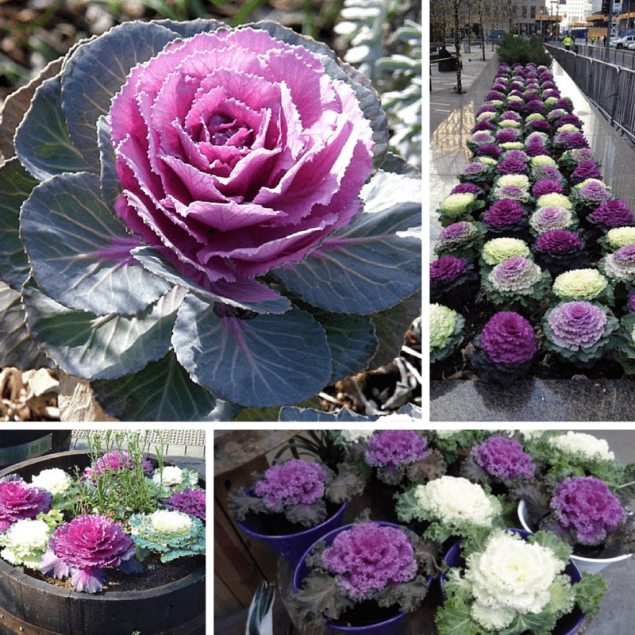
Like most garden plants, decorative cabbage, may be affected by cruciferous flea beetle, slugs and caterpillars. Especially dangerous such pests for young immature plants. Often to deal with them recommend the use of natural folk remedies. For example, for the destruction and prevention of fleas plants dusted with tobacco, red pepper, ash or a mixture of these three components. This treatment is best done after watering to mix better cling to wet leaves. When a small amount of pests, the flea can be washed off with cabbage leaves during watering-sprinkling.
To protect cabbages from slugs, you can use ash or pine needles, which strew the soil, and the plants themselves. Alsoto prevent the defeat of the decorative cabbages various pests next to plants planted marigolds, Basil, dill or calendula.
If the cabbage is grown purely for decorative purposes and is not planned the food, the leaves can be treated more effective pesticides or insecticides.
To avoid the risk of cabbage root diseases, in particular, famosa or Clubroot, it is important to carry out regular crop rotation to maintain the acid balance of the soil periodically and use of microbiological preparations.
How to collect the seeds of ornamental cabbage?
Ornamental Kale, which has traditionally reproduction is by seed, the plant is a biennial. And seeds ripen on the plants of the second year. In the fall, plants are dug with a clod of earth, cut off the lower leaves and added dropwise to spring in the sand. Transplanted rosettes ornamental cabbage in the winter stored in dry well ventilated place, making sure that the roots have not dried out. With the onset of spring as soon as weather conditions allow, decorative cabbage, growing and care where previously accomplished in greenhouses, again landed on the bed. That pollination was more effective, we need close to plant several plants.
Flowering biennial instances ornamental cabbage starts in June-July. Gradually in place of inflorescences formed pods in which to fall, and the seeds ripen. Because they love birds, during the summer of pods suggest to cover with a thin cloth. When the pods will dry up and turn yellow, they are cut and tied in a bun. Pair itself can be hung in a dry place, sending out under it the newspaper. After a couple of weeks the pods will eventually dosahnout and will be well luschitsya.
Planning to collect seeds from ornamental cabbage, the main thing to remember is that for their ripening varietal leave selected plants. If you have a flowerbed adorns one of the hybrids of this plant, collect the seeds fail to grow in subsequent years, seed will have to buy in the store.
Varieties of ornamental cabbage and their application
Today ornamental Kale in the flower bed not so frequent guest, although in the autumn she will give odds to any blooming plant. In addition, the simplicity of the daily view allows you to attach it to the flower gardens in August when the plant is every day becoming more and more bizarre form and color.
Like other varieties of cabbage, ornamental Kale can be eaten. However, its leaves have a somewhat bitter taste, get rid of which can promorail leaves before cooking of their food. But as we taste traditionally, taste has more white cabbage, ornamental varieties are still better to use for the decoration of the autumn garden of exotic shapes and colors.
People traditionally varieties of ornamental cabbage divided into two groups.
1. Japanese "roses"
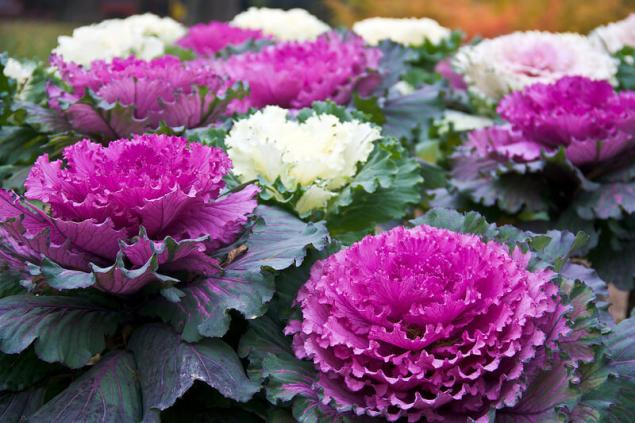
All varieties are easy to carry change of a place of growth and a short-lived night frosts to -12 degrees.
In landscape design these varieties are used for decoration borders, borders, parterres and flower beds. Ornamental cabbage grown whether to plant in place of the faded spring bulbs and early annuals. Large sockets allow you to use a much smaller number of plants for decoration of one flower garden in comparison with traditional annuals.
Popular varieties:
• cabbage ornamental Tokyo — bright middle white, pink, or reddish colors contrasting on a background of dark green leaves. Steel plate this cartoneria rounded with a slightly rippled or wavy edge, and the size of the plant rarely exceeds 35 cm;
• ornamental cabbage Osaka — very similar to the previous cartoneria, but has larger rosettes, which reach a diameter of 45 cm and a height up to 60 cm Edge of the sheet can be like almost straight and Kostomarov;
• ornamental Kale "Nagoya", the main feature which may serve as a dense, layered fringe at the edge of the leaf. Dense rosette up to 60 cm in size;
• ornamental Kale "sunrise" hybrid, the outlet of which resembles a blossoming rose pale cream shade;
• cabbage decorative"Peacock's tail" — class with carved foliage to a height not exceeding 30 cm, leaf color is often green with a white middle or purple with a raspberry core;
• cabbage ornamental "Pink egret" is one of the most spectacular hybrid varieties with pink leaf color and rosette-shaped rose flower. Reaches a height of about 45 cm.
2. Palm varieties of ornamental cabbage
In landscape design these plants often have on the back line mixborders. When planting annuals in the flower beds for they have a Central place with planting three plants together or single.
Popular varieties:
•"The language of the lark" — the sort of ornamental cabbage, which is characterized pustovarivske jagged edge green leaves reaching a length of about 70 cm with an overall height of plants approximately 120 cm;
• ornamental Kale red high – grade is very similar to the previous one, but has purple leaves up to 60 cm in length;
• cartoneria Kale plants with corrugated leaves lisoobrobna gray, red and green shades, often does not exceed 70 cm;
• cabbage ornamental"Kai and Gerda" — the first generation hybrid surprises mixed purple and green leaves with an overall height of 50-80 cm
Bizarre outlets and the variety of ornamental cabbage easily to a real decoration for the fall garden. published
P. S. And remember, only by changing their consumption — together we change the world! © Join us at Facebook , Vkontakte, Odnoklassniki
Source: sadovod-i-ogorodnik.ru/276-dekorativnaya-kapusta-vyraschivanie-i-uhod-posadka-rassadoy-i-semenami-v-grunt.html
What is ornamental Kale?
Essentially decorative cauliflower – this is the collective name of several varieties of cabbage leaf. It is a biennial plant that in the first year of vegetation, it develops a leaf rosette, and in the second year, flowering and fruiting. For decorating the area used the plants the first year.

Depending on variety flower cabbage decorative tall able to achieve from 20 to 130 cm and in diameter up to 1 m. Special decorative effect different leaves which may have a different shape and color of leaves. Sheet size different serogroup varies from 20 to 60 cm in length and from 10 to 30 cm in width. Ornamental Kale perennial surprising variety of forms sheet plate, which can be ovate and obovate, elliptical, and truncated ellipticheskoi. The edges of the leaf are serrated and silnoroslye. Surprising and painting the socket in which white, pink, purple, cream blend with light green or bluish-green.
Almost all varieties of ornamental cabbage light-requiring, but can grow in partial shade, however, full sun cabbage get larger, and the coloration is brighter.
How to grow ornamental cabbage:
soil preparation
Farming of cabbage decorative is virtually indistinguishable from the technology of cultivation of familiar cabbage. Planning to grow this plant, it should be remembered that it is better grown on loamy and sandy soils. For a good harvest and achieve the highest ornamental plants land for its growing better prepare since autumn. In particular, at this time, it is recommended to make fertilizer. 1 m. make the compost (3-4 kg), ammonium sulfate (20 g), potassium chloride (15 g), superphosphate (42 g). All fertilizers carefully buried in the soil. If the level of acidity of the soil is increased, then reduce it by using lime.
In the spring before planting ornamental cabbage in the soil at the site loosened and re-aligned. Choosing land for cultivation, it should be remembered that cabbage grows well in the places where she grew tomatoes, potatoes, onions, legumes, cucumbers and root vegetables.
Planting ornamental cabbage
It should be noted that the decorative cabbage, planting and care which, incidentally, is not distinguished by special difficulties, traditionally grown from seed in seedling method. The seedlings are sown in containers or greenhouses or in open ground.
1. Planting ornamental cabbage in the pot.

Growing ornamental cabbage from seed starts in late March and early April, when in small pots with a diameter of about 3-4 cm were sown at 2 seeds and buried them in the soil to a depth of about 1 cm Before sowing, the soil should be treated with a fungicide in order to avoid destruction of young plants of "blackleg".
If you keep sowings at a temperature of 18-20 degrees, then after about 2-5 days to sprout the first shoots. Care of such seedlings is simple. As soon as friendly growth, the seedlings are transferred to a cooler room. Care of seedlings, ornamental cabbage is simple. Periodically moderately watered young plants. With the emergence of the second true leaf and approximately 14 days before planting in open ground the seedlings are fed, using, for example, Kemira Wagon or NPK per 1 m sq of 1 tablespoon of fertilizer.
At the end of April – early may, pre-hardened seedlings are planted in open ground. By that time each plant should be 4 or 5 leaves. By the way, to plant ornamental cabbage once a permanent place is optional. Since the peak of its decoration is in the fall, its a long time you can grow in the garden, and by the autumn to replant in the garden.
2. Planting ornamental cabbage in the greenhouse.
For planting seedlings in the greenhouse, as, indeed, and containers, prepare the soil mixture consisting of sand, peat and garden soil at the rate of 2:1:2. It is important that the prepared layer of soil reached about 10-15 cm Before seeding, the soil is treated with a solution of potassium permanganate or fungicide for disinfection and prevention of fungal diseases of seedlings.
Seeds spread on 2 pieces in small dimples with a depth of about 1 cm and cover them with earth. To speed up germination, crops covered with foil. At this stage, the temperature in the greenhouse should be approximately 20 degrees. With the emergence the temperature was lowered to 12 degrees. Seedlings provide moderate watering and periodically loosen the soil. Planted in open ground the young shoots of the ornamental cabbage you can already with the advent of the second sheet.
3. Planting ornamental cabbage in the open ground.
As practice shows, the ornamental cabbage, planting and care which is originally carried out in open ground, is more hardened and resistant to negative environmental effects. To sow ornamental cabbage in the open ground starting from the beginning of April (if allowed by weather and climatic conditions of the region), providing crops for the first time a film cover.
Seeds are sown in loose soil, according to scheme 5 by 5 cm, closing up to a depth of 1.5 cm When sprouts appear, the crops thinned out, leaving stronger plants. In the future, as necessary, watered the seedlings, remove the weeds and loosen the soil.For permanent seedlings are transplanted 30-45 days, positioning plants according to the scheme 70 by 70 cm.
Further, to obtain large lace rosette decorative cabbage, you need to provide her timely care.
How to grow ornamental cabbage: particular care

This unusual decorative cabbage, growing and care which at times surprises with its simplicity, as well as other garden inhabitants, requires some attention.
The basic techniques of caring for ornamental cabbage are periodic loosening of soil with simultaneous destruction of weeds and regular abundant watering, the frequency of which is determined based on the characteristics of the soil and weather conditions. When growing ornamental cabbage in containers with a volume of 10-15 l watering is carried out every three days, but in the heat and every day. This kind of cabbage, the growth is quite powerful and surround the outlet, because the plant must periodically hill, in order to stimulate the appearance of additional roots and increase its stability.
Moreover, because of its simplicity ornamental cabbage is easy to transplant from place to place. During the season plant with a clod of earth can be transplanted 2-3 times. To quickly get accustomed on a new place, cabbage is recommended to feed a 1.5% solution of fertilizer, for example, "Kemira-Suite."
If before planting the soil was properly charged, then additional feeding throughout the season, she did not need. But if in advance to prepare the ground failed, then feed the ornamental cabbage can be in the soil. 10-14 days after transplanting to a permanent place of plants fertilized with urea or a solution of mullein, which is diluted at the rate of 1 liter cans 1 bucket of water. This fertilizer will promote more active growth of the leaves. The next stage of feeding is carried out 14 days after the first. This time, apply complex fertilizers with the same dosage that is used during landing.
Diseases and pests of ornamental cabbage

Like most garden plants, decorative cabbage, may be affected by cruciferous flea beetle, slugs and caterpillars. Especially dangerous such pests for young immature plants. Often to deal with them recommend the use of natural folk remedies. For example, for the destruction and prevention of fleas plants dusted with tobacco, red pepper, ash or a mixture of these three components. This treatment is best done after watering to mix better cling to wet leaves. When a small amount of pests, the flea can be washed off with cabbage leaves during watering-sprinkling.
To protect cabbages from slugs, you can use ash or pine needles, which strew the soil, and the plants themselves. Alsoto prevent the defeat of the decorative cabbages various pests next to plants planted marigolds, Basil, dill or calendula.
If the cabbage is grown purely for decorative purposes and is not planned the food, the leaves can be treated more effective pesticides or insecticides.
To avoid the risk of cabbage root diseases, in particular, famosa or Clubroot, it is important to carry out regular crop rotation to maintain the acid balance of the soil periodically and use of microbiological preparations.
How to collect the seeds of ornamental cabbage?
Ornamental Kale, which has traditionally reproduction is by seed, the plant is a biennial. And seeds ripen on the plants of the second year. In the fall, plants are dug with a clod of earth, cut off the lower leaves and added dropwise to spring in the sand. Transplanted rosettes ornamental cabbage in the winter stored in dry well ventilated place, making sure that the roots have not dried out. With the onset of spring as soon as weather conditions allow, decorative cabbage, growing and care where previously accomplished in greenhouses, again landed on the bed. That pollination was more effective, we need close to plant several plants.
Flowering biennial instances ornamental cabbage starts in June-July. Gradually in place of inflorescences formed pods in which to fall, and the seeds ripen. Because they love birds, during the summer of pods suggest to cover with a thin cloth. When the pods will dry up and turn yellow, they are cut and tied in a bun. Pair itself can be hung in a dry place, sending out under it the newspaper. After a couple of weeks the pods will eventually dosahnout and will be well luschitsya.
Planning to collect seeds from ornamental cabbage, the main thing to remember is that for their ripening varietal leave selected plants. If you have a flowerbed adorns one of the hybrids of this plant, collect the seeds fail to grow in subsequent years, seed will have to buy in the store.
Varieties of ornamental cabbage and their application
Today ornamental Kale in the flower bed not so frequent guest, although in the autumn she will give odds to any blooming plant. In addition, the simplicity of the daily view allows you to attach it to the flower gardens in August when the plant is every day becoming more and more bizarre form and color.
Like other varieties of cabbage, ornamental Kale can be eaten. However, its leaves have a somewhat bitter taste, get rid of which can promorail leaves before cooking of their food. But as we taste traditionally, taste has more white cabbage, ornamental varieties are still better to use for the decoration of the autumn garden of exotic shapes and colors.
People traditionally varieties of ornamental cabbage divided into two groups.
1. Japanese "roses"

All varieties are easy to carry change of a place of growth and a short-lived night frosts to -12 degrees.
In landscape design these varieties are used for decoration borders, borders, parterres and flower beds. Ornamental cabbage grown whether to plant in place of the faded spring bulbs and early annuals. Large sockets allow you to use a much smaller number of plants for decoration of one flower garden in comparison with traditional annuals.
Popular varieties:
• cabbage ornamental Tokyo — bright middle white, pink, or reddish colors contrasting on a background of dark green leaves. Steel plate this cartoneria rounded with a slightly rippled or wavy edge, and the size of the plant rarely exceeds 35 cm;
• ornamental cabbage Osaka — very similar to the previous cartoneria, but has larger rosettes, which reach a diameter of 45 cm and a height up to 60 cm Edge of the sheet can be like almost straight and Kostomarov;
• ornamental Kale "Nagoya", the main feature which may serve as a dense, layered fringe at the edge of the leaf. Dense rosette up to 60 cm in size;
• ornamental Kale "sunrise" hybrid, the outlet of which resembles a blossoming rose pale cream shade;
• cabbage decorative"Peacock's tail" — class with carved foliage to a height not exceeding 30 cm, leaf color is often green with a white middle or purple with a raspberry core;
• cabbage ornamental "Pink egret" is one of the most spectacular hybrid varieties with pink leaf color and rosette-shaped rose flower. Reaches a height of about 45 cm.
2. Palm varieties of ornamental cabbage
In landscape design these plants often have on the back line mixborders. When planting annuals in the flower beds for they have a Central place with planting three plants together or single.
Popular varieties:
•"The language of the lark" — the sort of ornamental cabbage, which is characterized pustovarivske jagged edge green leaves reaching a length of about 70 cm with an overall height of plants approximately 120 cm;
• ornamental Kale red high – grade is very similar to the previous one, but has purple leaves up to 60 cm in length;
• cartoneria Kale plants with corrugated leaves lisoobrobna gray, red and green shades, often does not exceed 70 cm;
• cabbage ornamental"Kai and Gerda" — the first generation hybrid surprises mixed purple and green leaves with an overall height of 50-80 cm
Bizarre outlets and the variety of ornamental cabbage easily to a real decoration for the fall garden. published
P. S. And remember, only by changing their consumption — together we change the world! © Join us at Facebook , Vkontakte, Odnoklassniki
Source: sadovod-i-ogorodnik.ru/276-dekorativnaya-kapusta-vyraschivanie-i-uhod-posadka-rassadoy-i-semenami-v-grunt.html



